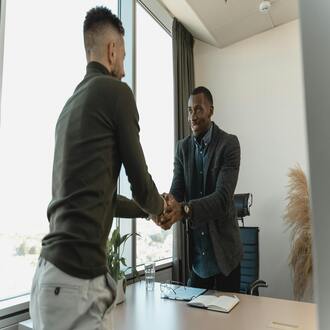Transcription Creating the Right Environment: Rapport and Physical Environment
Overcoming the Barrier of Artificiality (The Rapport)
The selection interview is inherently an artificial situation. Candidates often behave in a logical and calculated manner with the goal of being selected, which can mask their usual behavior.
This explains why sometimes the person hired acts very differently from how they presented themselves in the interview.
The most effective tool (perhaps the only one) to overcome this barrier of artificiality is the trust that the interviewer manages to generate.
This confidence is what allows the candidate to offer more natural and sincere answers.
Active Rapport Building Techniques
This trust is actively built through the initial "rapport" or "icebreaker" phase.
You should not wait until you are seated in the room to begin this phase; it should start from the moment you greet the candidate.
Rapport is achieved by looking for common ground, usually through neutral topics such as traffic, the weather or a non-personal detail that the candidate brings.
The interviewer can even share a brief anecdote (e.g., "I also encountered a lot of traffic") to alleviate the applicant's initial stress and generate empathy.
The Physical Environment: Privacy and Comfort
The physical space where the interview takes place plays a crucial role in building trust.
First, the location should be private and intimate, ensuring that there will be no distractions or interruptions from colleagues.
(If it is a panel interview, it is essential to have communicated this to the candidate in advance).
The room should be tidy and the lighting should be neutral, avoiding direct lights on the candidate that could simulate an interrogation.
Furniture and Psychological Distance
The arrangement of the furniture directly influences the power dynamics and the "psychological distance".
The classic obstacle of a large desk separating the interviewer from the candidate should be avoided at all costs, as this reinforces an image of authority. Ideally, the chairs should be on the same level.
If a table is required, it is preferable to use a small one that only partially covers the interviewee, encouraging a more open conversation.
The Interviewer's Preparation and Presence
Finally, the atmosphere is created by the interviewer.
It is vital to prepare the space and the agenda: have a clear desk, with only the necessary documents (the guide and the CV), and have set aside enough time so as not to be in a hurry.
Dress and language should be adapted to the level of the candidate to be interviewed; it is not appropriate to use overly formal language with operational staff, nor excessively flashy clothing.
Above all, the interviewer must show a genuine interest; this attitude is perceived and is key for the candidate to open up.
If the interview is virtual, this preparation involves ensuring that the invitation and link have been sent well in advance.
Summary
The interview is an inherently artificial situation. The most effective tool for overcoming this barrier and obtaining candid responses is trust.
This trust is actively built from the first greeting, seeking common ground with neutral topics. The physical space should be private, comfortable and uninterrupted.
The barrier of a large desk should be avoided; chairs on the same level are preferable. The interviewer should show genuine interest and have sufficient time set aside.
creating the right environment rapport and physical environment





![¡master the interview! online personnel selection course [free/paid]](/images/post/seleccion_personal_entrevista_trabajo1.webp)
![Effective personnel selection: course for companies [online]](/images/post/seleccion_personal_entrevista_trabajo4.webp)
